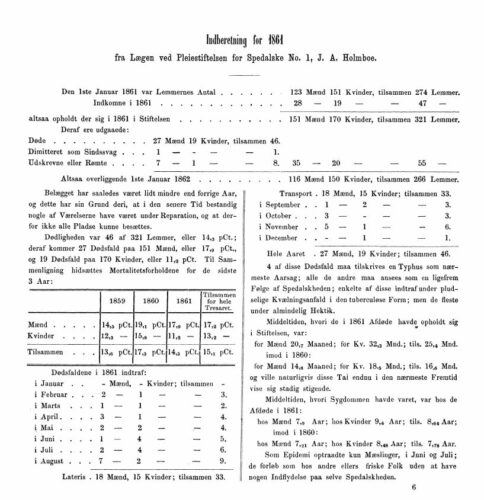The number of residents and how long they lived at Pleiestiftelsen
The hospital was pretty much full in its first decade, and it was difficult to get a place there. Even before the hospital opened, it had received a total of 355 applications for a place. Of these, 295 were given a place, but only 234 travelled to Bergen.
Although there was somewhat less demand after Reknes Hospital opened in 1860, the Chief Medical Officer for Leprosy proclaimed in 1863 that there were a large number of applications from the sick ‘who longed to be admitted’. There was still a shortage of places five years later, but over time fewer applications were submitted, so the number of residents also declined. Pleiestiftelsen Hospital was rumoured not to be a good place to stay, and as the number of new leprosy cases declined, fewer people needed a place.
In 1873, there were 244 residents at Pleiestiftelsen Hospital, and the doctor writes that there were 30 vacant places and no more applicants. By the end of 1890, the number of residents had dropped to 118 and 20 years later, in 1910, to 77. In 1930, only 39 residents remained. When Reidar Melsom resigned and thereby became the last doctor at Pleiestiftelsen in 1957, there were only five residents left. They had all been treated and were no longer considered infectious, but were allowed to continue living at Pleiestiftelsen at their own request.
The average age of the patients seems to have varied a great deal, as does the length of time residents had the disease and how long they lived at the hospital. In 1860, the average age of mortality was 37. Most had lived with the disease for between 7 and 8 years, and spent less than 18 months as a patient at the hospital.
Fifty years later, between 1911 and 1915, the picture had completely changed. The average age of mortality increased to 57.8 years and the average amount of time those patients had the disease was 25.2 years. In addition to increased life expectancy, those with leprosy were often admitted much earlier in the course of the disease, and therefore spent many years at Pleiestiftelsen. The average duration of their stay was now 16.7 years.
These averages, however, never show the huge differences between individual patients. Some residents only stayed at the hospital for a few months, while others stayed for decades. Patient number 6, Mons Johannesen Kleppe, for example, moved into Pleiestiftelsen as a 19-year-old on 26 June 1857. He lived there for 60 years, until his death in 1917. He appears to have visited his home in Samnanger three times, in 1858, 1862 and 1876.

From ‘Tables of leprosy patients in Norway’, produced by the Chief Medical Officer for Leprosy. www.ssb.no.




